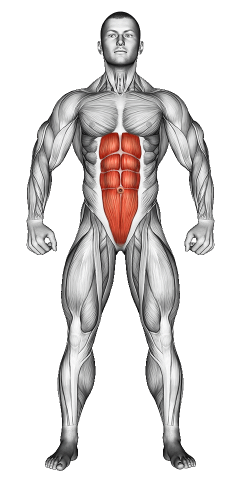Weighted Side Crunch: Video Tutorial & Exercise Guide

Written By: Claude Michael
Updated: Oct 13, 2024
| Workout | Weighted Side Crunch |
| Primary Muscle Group | Abs |
| Equipment Required | Weight |
| Force Type | Pull |
| Mechanics | Isolation |
| Exercise Type | Strength |
| Difficulty | Intermediate |
Weighted Side Crunch: Video Tutorial & Exercise Guide
- 1.Weighted Side Crunch: Muscle Groups
- -1.1Primary Muscle Group
- -1.2Secondary Muscle Group
- 2.Weighted Side Crunch: Step-by-Step Guide
- 3.Weighted Side Crunch: Overview
- 4.Weighted Side Crunch: Benefits
- 5.Weighted Side Crunch: Pro Tips & Advanced Techniques
- 6.Weighted Side Crunch: Progression Plan
- 7.Weighted Side Crunch: Frequently Asked Questions (FAQs)
Weighted Side Crunch: Step-by-Step Guide
- Step 1: Start by lying on your side with your knees bent and stacked on top of each other. Hold a dumbbell or weight plate in your top hand, resting it gently on your side.
- Step 2: Place your other hand behind your head to support your neck. Engage your core and lift your upper body off the ground, performing a side crunch.
- Step 3: Squeeze your obliques at the top of the movement, bringing your rib cage toward your hip.
- Step 4: Slowly lower your upper body back to the starting position, maintaining control of the weight.
- Step 5: Repeat for the desired number of repetitions, then switch to the other side.
Weighted Side Crunch: Overview
The Weighted Side Crunch is an effective exercise for targeting the obliques and building core strength. By adding weight to the traditional side crunch, you increase the resistance, helping to enhance muscle development in the core, especially the sides of the abdomen. This movement is great for developing the muscles needed for a well-rounded core and for improving stability and balance.
This exercise can be easily performed at home or in the gym using a dumbbell, weight plate, or even a kettlebell for added resistance. It’s an excellent addition to any ab-focused routine.
Weighted Side Crunch: Benefits
Weighted Side Crunches are excellent for strengthening and toning the obliques, which play a crucial role in trunk rotation and lateral stability. This exercise helps to create a more defined waistline while improving core strength and stability, which is essential for everyday movements and athletic performance.
Additionally, by increasing the resistance with weights, you can challenge your muscles more effectively, leading to improved muscle endurance and growth.
Weighted Side Crunch: Pro Tips & Advanced Techniques
To get the most out of this exercise, ensure that you maintain control of the weight throughout the movement. Avoid using momentum to lift your torso and focus on engaging your obliques to perform the crunch. For added difficulty, you can increase the weight or slow down the tempo of the exercise to increase time under tension.
Weighted Side Crunch: Progression Plan
Beginner
Intermediate
Advanced
Weighted Side Crunch: Frequently Asked Questions (FAQs)
What muscles do Weighted Side Crunches target?
+This exercise primarily targets the obliques, the muscles on the sides of your abdomen, but it also engages your core and hip muscles to a lesser extent.
Can beginners do Weighted Side Crunches?
+Yes! Beginners can start with no weight or a very light weight to focus on form and building strength before increasing resistance.
How can I make Weighted Side Crunches more challenging?
+To increase the difficulty, you can either increase the weight, slow down the tempo, or perform the exercise on a stability ball to challenge your balance and core even more.
How often should I do Weighted Side Crunches?
+Incorporate this exercise 2-3 times a week as part of your core workout routine for optimal results in strength and definition.
What common mistakes should I avoid during Weighted Side Crunches?
+Avoid using momentum to lift your torso and keep your movements slow and controlled. Make sure you're using your obliques to perform the movement, not your arms or shoulders.
Share
Don’t Wish for It, Work for It – Join the FlexXP Newsletter Today!
Thank you for signing up for the FlexXP Newsletter!
This site is protected and the Google Privacy Policy and Terms of Service apply.
